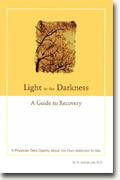Light in the Darkness
St. George Lee, MD
book reviews:
· general fiction
· chick lit/romance
· sci-fi/fantasy
· graphic novels
· nonfiction
· audio books
· author interviews
· children's books @
curledupkids.com
· DVD reviews @
curledupdvd.com
newsletter
win books
buy online
links
home
for authors
& publishers
for reviewers

 |
Light in the Darkness: A Guide to Recovery from Addiction St. George Lee Dragon Press Hardcover 184 pages July 2000 |
|
Light in the Darkness: A Guide to Recovery is an autobiographical account of cardiologist St. George Lee's experience with recovery from sexual addiction -- in his case, played out in repeated extramarital affairs over two decades. One only has to read the author's definition of addiction to grasp the isolated, indefinable, subjective tone of the self-disclosing commentary to follow. Addiction is "a search for God, gone awry."
Lee incorporates a variety of definitions and quotes to try to get at a description of the essential "high" feelings and desperate mental states inherent in any kind (e.g., drugs, alcohol, gambling, sex, tobacco) of addiction. For example, a lack of self awareness of problems which leads one to find a substance or fixate on an object as the "external solution," acting out behavior with a person or symbolic object that eventually takes control over one's life. At times an addictive person may have feelings akin to feeling possessed or even responsible for all the troubles of the world. Unconscious dynamics similar to having a multiple personality or dual (private/secretive self versus public) roles in life may be played out. The psychoanalyst Carl Jung's writings suggested to the author that addiction can be a neurotic substitute for legitimate suffering or emotional pain. Thus experiencing shame, feeling inadequate, failing to accept vulnerabilities, or never asking for help can lead one to cover up with denial, rigidity, grandiosity, perfectionism, "false fronts," blaming and the use of others for distorted, unrealistic, addictive purposes. Light in the Dark is organized alphabetically (excluding a handful of letters) into concepts related to addiction (e.g., Amends...) and key elements (e.g. Boundaries; Christianity, Denial, Ego, Forgiveness, God, Honesty, Intellectualizing, Jesus, Letting go, Nurturing, Pride, Resentment, Serenity, Vulnerability, Witnessing) in recovery. The author prescribes a Twelve-Step program, modeled along the lines of Alcoholics Anonymous with individual (e.g., Jungian psychodynamics), group, and codependency counseling for recovery from apparently any addiction. How elements of recovery will be joined, confronted, and used by the individual will depend on their expanded awareness of defenses and willingness to make conscious "darker," fearful, shameful content. Ultimately, the exploratory uncovering goal of "the heart" connects with higher emotional, spiritual purposes. Within this process the individual begins to understand, forgive, love, and accept himself instead of resorting to addictive behavior. Professional counselors will empathize with the struggles going on behind the words, examples, and intermittent flow of discussion in the book. Addiction plays no favorites, and there are never any "quick fixes." The rich, educated, professional, and even socially well-connected who suffer with addiction go through much if not all the pain, conflicts, confrontations, misunderstandings, and realistic compromises alluded to and touched upon repeatedly in recovery. Light in the Darkness represents a long, difficult personal struggle, but a deeply moving therapeutic experience for the author. It is highly recommended to anyone needing help with an addiction or interested in learning about a Twelve-Step approach and the components of this kind of treatment. The book may also be helpful to anyone maintaining a library of reference materials for prospective AA members, including those who attend open meetings for fellowship, Al-Anon, and codependency purposes.
|
|
|
|
 Click here to learn more about this month's sponsor! |
|
| fiction · sf/f · comic books · nonfiction · audio newsletter · free book contest · buy books online review index · links · · authors & publishers reviewers |
|
| site by ELBO Computing Resources, Inc. | |
 The author traces his awareness of pathology
to sucking his thumb as a child (which persisted to age 13). This behavior in the presence of
a critical mother often triggered her hostility and rejecting behavior towards him rather than consistent nurturing and acceptance of Lee as an insecure, yet growing young man. Later, the
author suggests there were other sexual "goings on" in the parental home (there's little reference
to the father), but he never ventures into any explicit details. No exciting "cutting edge"
research studies or original treatment options are presented. Little attention is given to how
the author's wife, marriage, and primary family functioned before his sexual acting out, during
his "secret" affairs, or after the loss of medical/public standing and hospital privileges. What started his sexual acting-out behavior? What family dynamics caused unfeeling rigidities, the maintenance of fixed role relationships (e.g., controlling, codependent), and dysfunctional consequence to result in his acting out sexually?
The author traces his awareness of pathology
to sucking his thumb as a child (which persisted to age 13). This behavior in the presence of
a critical mother often triggered her hostility and rejecting behavior towards him rather than consistent nurturing and acceptance of Lee as an insecure, yet growing young man. Later, the
author suggests there were other sexual "goings on" in the parental home (there's little reference
to the father), but he never ventures into any explicit details. No exciting "cutting edge"
research studies or original treatment options are presented. Little attention is given to how
the author's wife, marriage, and primary family functioned before his sexual acting out, during
his "secret" affairs, or after the loss of medical/public standing and hospital privileges. What started his sexual acting-out behavior? What family dynamics caused unfeeling rigidities, the maintenance of fixed role relationships (e.g., controlling, codependent), and dysfunctional consequence to result in his acting out sexually?